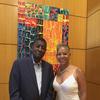Smithsonian American Art Museum Announces Formation of American Art Collaborative
- WASHINGTON, DC
- /
- February 02, 2015
The Smithsonian American Art Museum has announced the creation of The American Art Collaborative (AAC), a consortium of 14 American museums committed to building the next generation of digital searches and scholarly advancement. Members of the Collaborative are meeting in Washington, D.C., this week to move from planning to implementation of their Linked Open Data Initiative, which seeks to expand the possibilities inherent in linking museum collections through Linked Open Data (LOD).
The Collaborative plans to create a diverse critical mass of LOD on the Web on the subject of American art by putting the collections of the participating museums in the cloud and tagging this data as LOD. This will exponentially enhance the accessing, linking and sharing of information about American art in a way that transcends what is currently possible with structured data. The goals of the Initiative are to simplify access to digital information across museum collections for both researchers and the public, to increase the understanding and appreciation of American art, to create new opportunities for discovery, research and collaboration, to promote creative reuse of data on American art across numerous applications and to showcase for museums and other scholarly institutions the inherent possibilities of LOD.
The Smithsonian American Art Museum is the lead museum for the Collaborative and will host the February meeting. The museum is at the forefront of museum-related digital initiatives and was one of the first American museums to make its entire collection available on the cloud via LOD. The museum’s online collection and database of authoritative research now connect to a growing body of related data published by organizations worldwide.
“Art museums share a commitment to helping audiences of all ages experience, learn about, appreciate and enjoy art—thus our missions also include promoting access to our Smithsonian American Art Museum NewsSI-38-2015 2 collections and research,” said Betsy Broun, the Margaret and Terry Stent Director of the Smithsonian American Art Museum.
The planning phase for the Initiative was made possible through a grant from the Andrew W. Mellon Foundation awarded to the museum on behalf of the AAC.
Eleanor Fink, an expert in the field of digital cultural heritage who has held leadership positions at the Smithsonian, J. Paul Getty Trust, Getty Information Institute and the World Bank, conceived of and co-manages the Collaborative with Rachel Allen, deputy director of the Smithsonian American Art Museum.
The 14 museums participating in the Collaborative represent some of the most important collections of American Art in the world. Those museums are the Amon Carter Museum of American Art in Fort Worth, Texas, the Smithsonian’s Archives of American Art in Washington, D.C., the Autry National Center in Los Angeles, the Colby College Museum of Art in Waterville, Maine, Crystal Bridges Museum of American Art in Crystal Bridges, Ark., the Dallas Museum of Art in Dallas, the Thomas Gilcrease Museum in Tulsa, Okla., the Indianapolis Museum of Art in Indianapolis, the National Museum of Wildlife Art in Jackson Hole, Wyo., the Smithsonian’s National Portrait Gallery in Washington, D.C., the Princeton University Art Museum in Princeton, N.J.; the Smithsonian American Art Museum in Washington, D.C.; the Yale Center for British Art in New Haven, Conn., and the Walters Art Museum in Baltimore.
The Collaborative will provide training, technical support and guidance to help the participating museums convert their data in an effort to explore the value of LOD to the discipline of art history and to establish sustainable approaches that other museums can follow.
“Ultimately, we hope to demonstrate the power of Linked Open Data to the museum world and to the study of American art, history and culture in order to inspire more museums to follow suit and to continue to build on the possibilities presented by the Web,” Broun said.






__2016_100x100_c.jpg)



![Peter Paul Rubens (Flemish, 1577–1640), After Titian (Tiziano Vecelli) (Italian [Venetian], c. 1488–1576), Rape of Europa, 1628–29. Oil on canvas, 71 7/8 x 79 3/8 in. Peter Paul Rubens (Flemish, 1577–1640), After Titian (Tiziano Vecelli) (Italian [Venetian], c. 1488–1576), Rape of Europa, 1628–29. Oil on canvas, 71 7/8 x 79 3/8 in.](/images/c/e2/2e/Jan20_Rape_of_Europa100x100_c.jpg)





